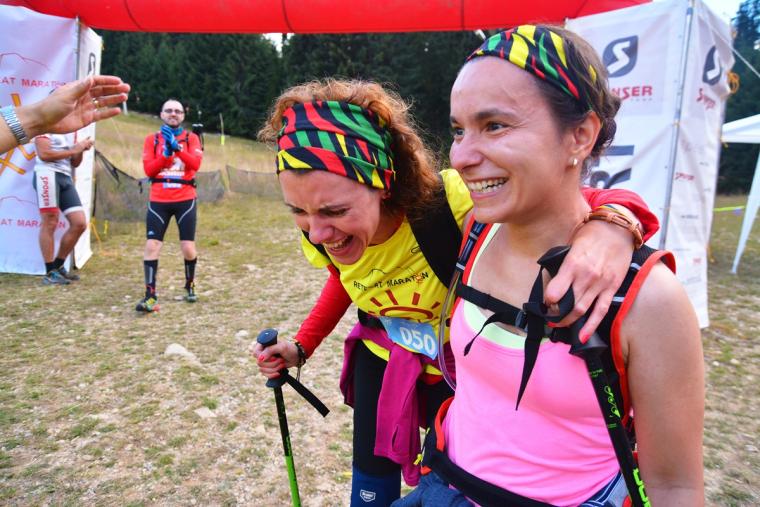
Fresh air, scenic and traffic-free environs, a fun and relaxed tempo, and joint-friendly terrain (at least as compared to road running’s paved and hard surfaces), are among the many reasons that a growing number of people are taking part in trail running these days. And it certainly doesn’t hurt that brands and marketers are lavishing dollars and attention on athlete and event sponsorships, marketing initiatives, product R&D and the like, helping to raise the sport’s profile beyond the core participant base.
Trail running, which combines Americans’ love of the outdoors with their enthusiasm for running, jumped from 13.2 million participants in 2022 to 14.8 million in 2023, a one-year increase of 12.3 percent, according to the SFIA’s 2024 Topline Participation Report. What’s more, the study found that in the three years spanning 2021-2023, trail running participation soared 25.6 percent.
Interestingly, the trail running demographic skews older than one might imagine. RunRepeat’s “Ultimate Trail Running Stats (197 Facts)” revealed that 90 percent of trail runners are between the ages of 22 and 55, and the largest demographic of trail runners is 25-44 years old. The article also pointed out that 36.5 percent of trail runners are women. Other data points to consider: 56 percent of trail runners have been running for six years or more; 44 percent run three to five days per week; 48 percent run between six and 20 miles per week total; and the average trail runner gets out onto the trails 31.8 days per year.
 On the competition front, a recent study conducted by RunRepeat in conjunction with World Athletics revealed that trail running is unique compared to road running by having an extreme diversity in distances, whereas road running mainly focuses around the classic 5k, 10k, half-marathon and marathon.
On the competition front, a recent study conducted by RunRepeat in conjunction with World Athletics revealed that trail running is unique compared to road running by having an extreme diversity in distances, whereas road running mainly focuses around the classic 5k, 10k, half-marathon and marathon.
Ultramarathons are unquestionably becoming more popular, as evidenced by the increasing visibility of events such as the UTMB World Series, the Western States 100, the Hardrock 100 and the Leadville Trail 100. These are helping to attract trail-curious runners to other trail races that are not necessarily ultra distances, such as the Golden Trail World Series in which the races held in 2023 ranged from 21k to 42k (roughly half-marathon to marathon distances).
Trail Runner Magazine spoke with a couple of Golden Trail participants who were enthusiastic about the short-and-fast format. “[The Golden Trail] is fun because it’s based on short and fast trail racing, which is what I love,” said Allie McLaughlin, a Hoka-sponsored trail runner from Colorado Springs. “It’s just a different vibe than a lot of races.” Similarly, Dani Moreno, an Adidas-Terrex pro from Mammoth Lakes, California, remarked, “I think it’s much more approachable. If you told someone who wanted to get into trail running that they could only do a 100-miler, most would say, ‘Uh, no thank you.’ The point is that the performances of runners at shorter distances are just as impressive as the runners doing longer distances.”
The shorter and faster style of racing is also aligned with the massive growth in the mainstream among recreational runners. RunRepeat pegged trail running’s growth at 231 percent over the past 10 years, but noted the average trail race length is only 24k, or about 15 miles.
Generally speaking, many trail running events—whether for serious competitors or for the more health and recreation-minded set, often have a more lighthearted vibe than road races. A recent Reddit thread asked, “Can anyone explain why trail running is getting so popular?” Some of the responses were enlightening (not to mention snack-focused). “IDK, I hear at trail running aid stations they hand out Oreos and stuff and that’s a decent selling point in itself compared to road races,” remarked one contributor. Another wrote, “I was at a race where they were handing out warm potato soup and pasta at the end. Beats 30 bananas and a Gu pouch any day.” And who can really argue with, “Nature. Mental health. Easier on the body. I think for runners it’s been popular for a while.”
Apparently, there’s a lot of money in them thar hills. From a global perspective, Allied Market Research published a report titled, “Trail Running Shoes Market by Type (Light Trail Running Shoes, Rugged Trail Running Shoes, Off Trail Running Shoes, and Others), Gender (Unisex, Male, and Female), and Sales Channel (Online and Offline): Global Opportunity Analysis and Industry Forecast, 2023-2032.” One of the key findings was that the trail running shoes market was valued at $7.3 billion in 2022, and is estimated to reach $12.4 billion by 2032, growing at a CAGR of 5.5 percent from 2023 to 2032.
The study further states, “Advancements in materials, biomechanics, and design have driven innovation in footwear technology, leading to increased demand for trail running shoes. The availability of features such as enhanced traction, durability, and lightweight construction fulfills the needs of outdoor enthusiasts seeking high-performance gear. These innovations improve the overall running experience and offer superior comfort and protection on rugged terrain. As a result, consumers prefer trail running shoes that provide advanced functionality and support for their outdoor activities, thereby contributing to the growth of the market.”
Here are a couple of other key takeaways from Allied Market Research. By gender, the male segment held the highest market share in 2022, accounting for more than half of the global trail running shoes market revenue. However, the female segment is projected to manifest the highest CAGR of 5.9 percent from 2023 to 2032, with more women participating in outdoor activities, driving the need for specialized footwear designed for their unique preferences and requirements. By region, North America held the highest market share in terms of revenue in 2022, accounting for nearly one-third of the global trail running shoes market revenue in this region. North America is projected to maintain its dominance by 2032.
The question now is, can trail running continue on its current trajectory? Some experts believe the core issue is retention versus attraction. “We should tilt the balance toward retention. This is not merely a survival strategy; it's an opportunity to cultivate a passionate, committed community that will, in turn, attract others. Depth breeds width, not the other way around,” opines David Callahan, Co-CEO of UltraSignup, a leading registration and race database in trail running. “So, we’ve accomplished what Ray Kinsella set out to do in Field of Dreams—we have built it and they have come. Now, we must take on the second act—support them and they will stay.”

